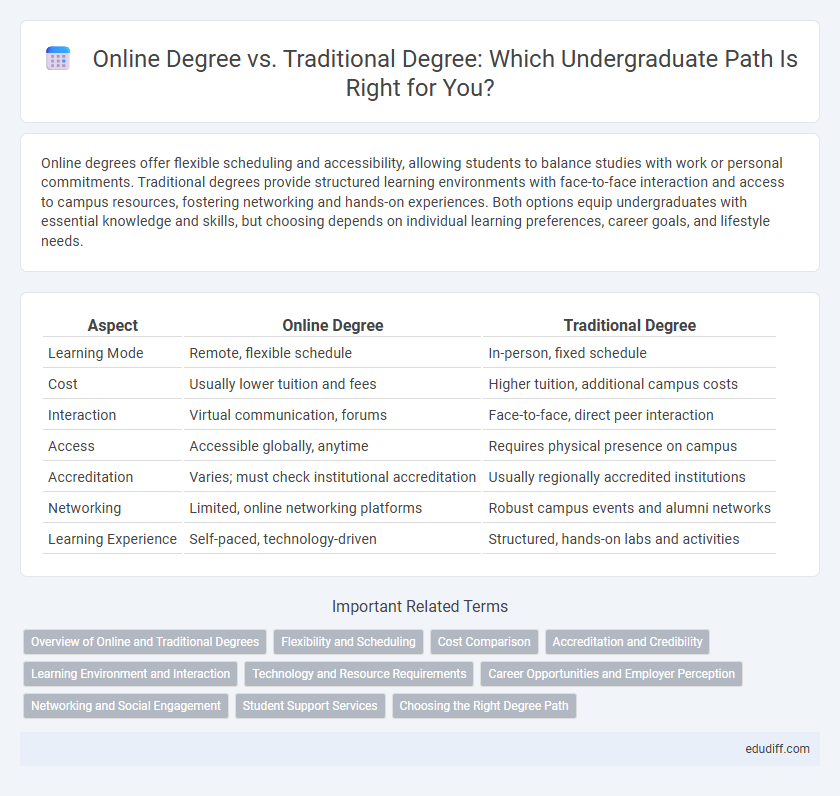Online degrees offer flexible scheduling and accessibility, allowing students to balance studies with work or personal commitments. Traditional degrees provide structured learning environments with face-to-face interaction and access to campus resources, fostering networking and hands-on experiences. Both options equip undergraduates with essential knowledge and skills, but choosing depends on individual learning preferences, career goals, and lifestyle needs.
Table of Comparison
| Aspect | Online Degree | Traditional Degree |
|---|---|---|
| Learning Mode | Remote, flexible schedule | In-person, fixed schedule |
| Cost | Usually lower tuition and fees | Higher tuition, additional campus costs |
| Interaction | Virtual communication, forums | Face-to-face, direct peer interaction |
| Access | Accessible globally, anytime | Requires physical presence on campus |
| Accreditation | Varies; must check institutional accreditation | Usually regionally accredited institutions |
| Networking | Limited, online networking platforms | Robust campus events and alumni networks |
| Learning Experience | Self-paced, technology-driven | Structured, hands-on labs and activities |
Overview of Online and Traditional Degrees
Online degrees provide flexible learning environments through digital platforms, allowing students to access courses anytime and anywhere. Traditional degrees require in-person attendance, offering direct interaction with professors and peers, often on-campus. Both formats deliver accredited curricula, but modality impacts the learning experience, schedule adaptability, and networking opportunities.
Flexibility and Scheduling
Online degrees offer unparalleled flexibility, allowing students to access coursework and complete assignments on their own schedules, which suits those balancing work or family commitments. Traditional degrees typically require fixed class times and on-campus attendance, making scheduling less adaptable but providing structured learning environments. Students prioritizing time management and personalized pacing often prefer online programs, while those valuing in-person interaction and routine may opt for traditional degrees.
Cost Comparison
Online degrees typically offer lower tuition fees and eliminate expenses related to campus housing, transportation, and campus facilities, making them more cost-effective than traditional degrees. Traditional degree programs often involve additional costs such as campus amenities, commuting, and sometimes higher administrative fees, increasing the overall financial burden. Considering these factors, students pursuing an undergraduate degree can significantly reduce educational expenses by opting for an online degree program.
Accreditation and Credibility
Accreditation plays a crucial role in determining the credibility of both online and traditional undergraduate degrees, ensuring that the institution meets established academic standards. Regional accreditation is widely recognized as the benchmark for quality and is essential for credit transfer and employer acceptance. Prospective students should verify an online program's accreditation status through agencies recognized by the U.S. Department of Education or CHEA to ensure their degree holds value comparable to traditional credentials.
Learning Environment and Interaction
Online degrees offer flexible learning environments with digital platforms that facilitate access to course materials anytime, promoting self-paced study and virtual collaboration through forums and video conferencing. Traditional degrees provide structured classroom settings that encourage face-to-face interaction, spontaneous discussions, and hands-on activities, fostering immediate feedback and social engagement. Both environments shape the nature of student-instructor and peer interactions, influencing learning dynamics and academic support experiences.
Technology and Resource Requirements
Online degrees rely heavily on stable internet connections, advanced learning management systems, and digital collaboration tools to facilitate remote education. Traditional degrees require physical access to campus facilities, including libraries, laboratories, and face-to-face interaction with faculty and peers. Technology integration in online programs demands continuous updates and digital literacy, whereas traditional programs emphasize in-person resource availability and infrastructure.
Career Opportunities and Employer Perception
Online degrees increasingly match traditional degrees in career opportunities, particularly when accredited and from reputable institutions. Employers prioritize skills and relevant experience, often valuing online degree holders equally if their education demonstrates practical expertise. Studies indicate that sectors like technology and business are more accepting of online credentials, while some conservative industries may still favor traditional degrees.
Networking and Social Engagement
Online degrees offer flexible learning environments but often lack the in-person networking opportunities found in traditional degree programs, which foster face-to-face interactions and collaborative experiences. Traditional degrees provide access to campus resources, clubs, and events that enhance social engagement and professional relationship-building critical for career development. Virtual platforms attempt to simulate these interactions, though they may not fully replicate the depth and spontaneity of connections formed on physical campuses.
Student Support Services
Online degree programs offer extensive virtual student support services including 24/7 academic advising, tutoring, and technical assistance tailored to remote learners. Traditional degrees provide in-person support such as face-to-face counseling, career centers, and campus resources that foster direct interpersonal interaction. Access to comprehensive student support services significantly impacts academic success and overall student satisfaction across both online and traditional degree pathways.
Choosing the Right Degree Path
Choosing the right degree path involves evaluating factors such as flexibility, cost, and accreditation between online degrees and traditional degrees. Online degrees offer convenience and accessibility for remote learners, whereas traditional degrees provide in-person interaction and campus resources that enhance networking opportunities. Prospective students should assess their learning style, career goals, and available time commitments to determine which degree format best aligns with their academic and professional objectives.
Online Degree vs Traditional Degree Infographic

 edudiff.com
edudiff.com